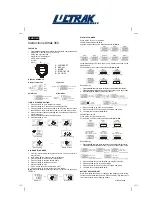
31
30
Contents
Page
1. Radio technology
31
2. Environmentally friendly solar technology
34
3. Automatic time synchronisation
34
4. Functions
37
5. Selectable LC displays
39
6. Reception indicator
39
6.1 Manual time synchronisation
40
6.2 Setting the time zone
43
6.3 Quartz mode
43
7. Ready for use
44
8. Charge level indicator on watches using solar power
45
8.1
Restart/Starting following complete discharge
of the energy store
46
9. Charging times
47
9.1 Daily operation
47
9.2 Following complete discharge
48
10. General information
49
11. Technical information
50
12. Water resistance
51
1. Radio technology
The most uptodate way to keep time.
5,000 years have passed since timekeeping began with sundials. In
the interim there have been water clocks, the mechanical clocks of the
13th century and quartz watches. Now we have the Junghans radio-
controlled watch. This is a watch that, with good reception, will never
go wrong and never need setting. The Junghans radio-controlled watch
is absolutely precise, as it is linked via radio technology to the timing
control of the most accurate clock in the world, For Europe this is the
Caesium Time Base at the Physikalisch-Technischen Bundesanstalt
in Braunschweig (Germany’s Institute of Natural and Engineering
Sciences). For Japan the Caesium Time Base of the National Institute
for Information and Communications Technology (NICT), a public
administration authority organisation. For North America it is the U.S.
Commerce Department’s Caesium Time Base at the National Institute
of Standards and Technology (NIST) in Boulder, Colorado. These clocks
are so accurate that they are expected to deviate by no more than
1 second in a million years.
































